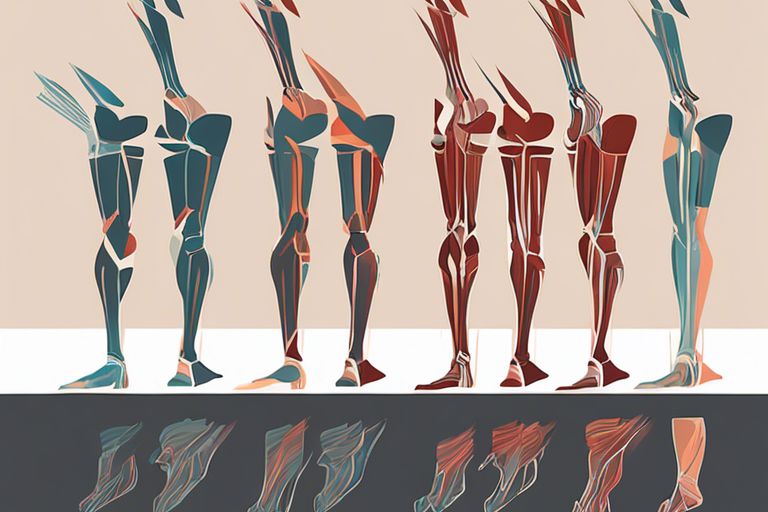Have you ever wondered how your daily walking habits affect your bone health? Research has shown that walking regularly can have a significant impact on your bone density, which is crucial for maintaining strong and healthy bones. By engaging in weight-bearing exercise like walking, you can help prevent bone loss and reduce the risk of fractures. However, it’s important to understand the potential risks and benefits associated with walking for your bone health. In this blog post, we will explore the impact of walking on bone density and provide you with valuable insights to help you make informed decisions about your physical activity habits.
Explaining Bone Density and Osteoporosis
To understand the impact of walking on bone density, it is important to first comprehend the concept of bone density and osteoporosis. Bone density refers to the amount of mineral matter in a certain volume of bone, which determines its strength and density. Osteoporosis, on the other hand, is a condition characterized by low bone density and deterioration of bone tissue, leading to increased bone fragility and susceptibility to fractures. This condition is particularly prevalent in older adults, especially women, and can have significant implications on mobility and overall quality of life.
Understanding Bone Remodeling
Bone remodeling is a continuous process where old bone tissue is broken down and replaced by new bone tissue. This process is crucial for maintaining bone strength and density. Your physical activities, including walking, play a key role in stimulating bone remodeling and promoting the formation of new, stronger bone tissue. Therefore, regular walking can contribute to maintaining and improving your bone density, reducing the risk of osteoporosis and fractures.
Risk Factors for Low Bone Density
There are several factors that can contribute to low bone density and increase the risk of osteoporosis. These include age, gender (women are at a higher risk), family history of osteoporosis, excessive alcohol consumption, smoking, sedentary lifestyle, and inadequate calcium and vitamin D intake. Additionally, certain medical conditions and medications can also affect bone health. Therefore, it is crucial to be aware of these factors and take proactive steps to mitigate their impact on your bone density. Though some of these risk factors are beyond your control, there are lifestyle choices you can make to minimize their impact on your bone health.
Walking and its Effects on Bone Health
Some people think of walking as a leisurely activity, but it has far-reaching effects on your bone health. The impact of walking on bone density and strength is well-documented, making it an essential component of maintaining strong and healthy bones.
The Science of Walking and Bone Stimulation
When you walk, the impact of your feet hitting the ground sends signals to your bones, prompting them to grow stronger and denser. This weight-bearing activity stimulates the bone-forming cells, leading to improved bone density over time. Regular walking also helps to maintain balance and coordination, reducing the risk of falls and fractures as you age.
Comparative Impact of Walking vs. Other Exercises
When comparing the impact of walking to other forms of exercise on bone density, walking holds its own as a highly effective option. While high-impact activities like running and jumping may provide slightly greater benefits, walking is more accessible and lower in risk. Here is a comparative breakdown of the impact of walking versus other exercises on bone health:
| Walking | Other Exercises |
| Accessible to all fitness levels | May require specific training or equipment |
| Low risk of injury | Higher risk of impact-related injuries |
| Easily incorporated into daily routine | May require dedicated workout time |
Overall, walking proves to be an excellent option for improving and maintaining bone health, especially as you age. Its low barrier to entry, minimal risk of injury, and consistent impact on bone density make it an ideal choice for individuals of all ages and fitness levels.
Practical Guidelines for Walking to Improve Bone Density
Now that you understand the impact of walking on bone density, you may be wondering how to incorporate it into your routine effectively. Here are some practical guidelines to help you get the most out of your walking routine and improve your bone density.
Recommended Frequency and Duration of Walks
When it comes to walking to improve bone density, consistency is key. Aim for at least 30 minutes of brisk walking most days of the week. This will help stimulate bone growth and maintain bone density. If you’re just starting out, you can begin with shorter walks and gradually increase the duration as your fitness level improves. Remember, it’s important to find a balance and not overexert yourself, as this can lead to injury.
Tips for Maximizing Bone Density Benefits
When walking to improve bone density, there are a few tips you can follow to maximize the benefits. First, make sure to engage in weight-bearing walking, which means putting pressure on your bones by walking on your feet. This could include brisk walking, hiking, or even using a treadmill with an incline. Additionally, incorporating strength training exercises into your routine can further enhance bone density. Lastly, ensure you are getting enough calcium and vitamin D in your diet to support bone health.
- Engage in weight-bearing walking such as brisk walking or hiking
- Incorporate strength training exercises into your routine
- Ensure you get enough calcium and vitamin D in your diet
Perceiving significant improvement in your bone density will take time and consistency, so be patient and stay dedicated to your walking routine. By following these tips and guidelines, you can effectively improve your bone density and overall bone health.
Impact of Walking on Bone Density
So, as you can see, walking has a significant impact on bone density. Regular walking, especially weight-bearing and resistance walking, promotes the growth of new bone tissue, strengthens existing bone, and reduces the risk of osteoporosis. By incorporating walking into your regular exercise routine, you can ensure that you are maintaining and improving your bone health for the long term. Remember, consistency is key when it comes to reaping the benefits of walking on bone density, so make sure to prioritize this form of exercise in your daily life.




